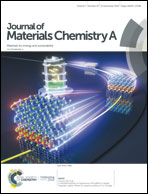Structure reorganization-controlled electron transfer of bipyridine derivatives as organic redox couples†
Abstract
Aqueous organic redox flow battery (AORFB) is one of the attractive technologies for renewable energy storage. The electronic effect or steric effect of the functional groups are commonly under discussion to screen the appropriate organic electrolytes for AORFBs. However, the role of structural reorganization on the electron transfer process of organic electrolytes in AORFBs is still not clear. In this work, we study the electrochemical properties of three bipyridine derivatives as organic electrolytes for AORFBs. The influence of structural reorganization on the electron transfer is investigated by changing the type and position of the functional groups of the bipyridine derivatives. Density functional theory (DFT) calculation reveals that the molecular structures of three molecules have a noticeable difference due to the steric effect of the functional groups. Furthermore, the rate constants of 1,1′-ethylene-2,2′-bipyridinium dichloride and methyl viologen are significantly higher than that of 1-methyl-2-(1-methylpyridin-1-ium-2-yl)pyridin-1-ium dichloride due to the much lower reorganization energy. As a result, a single battery using 1,1′-ethylene-2,2′-bipyridinium dichloride as the organic electrolyte shows excellent cell performance with the energy efficiency of 67.18% and excellent cycling stability with a capacity retention of 99.95% per cycle at the current density of 100 mA cm−2.



 Please wait while we load your content...
Please wait while we load your content...